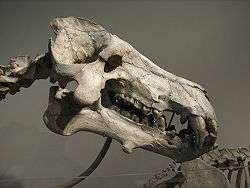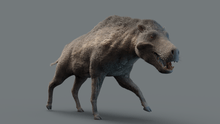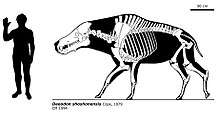Daeodon
Daeodon (from Greek, δαίος, daios "hostile" or "dreadful", and οδον, odon "teeth") is an extinct genus of entelodont artiodactyl that inhabited North America between 29 and 19 million years ago during the middle Oligocene and early Miocene epochs. The type species is Daeodon shoshonensis, the last and largest of the entelodonts; known adults of this species possessed skulls about 90 cm (3 ft) in length. It had a broad distribution across the United States, but it was never abundant.
| Daeodon | |
|---|---|
 | |
| A skull of Daeodon shoshonensis at the Carnegie Museum of Natural History. | |
| Scientific classification | |
| Kingdom: | Animalia |
| Phylum: | Chordata |
| Class: | Mammalia |
| Order: | Artiodactyla |
| Family: | †Entelodontidae |
| Genus: | †Daeodon Cope, 1878 |
| Type species | |
| †Daeodon shoshonensis Cope, 1878 | |
| Species | |
| |
| Synonyms | |

Lower_Miocene_of_Nebraska.jpg)
Etymology
Although not specified in Cope's original description, the name Daeodon comes from the Greek words daios, meaning "hostile" or "dreadful" and odon, meaning "teeth".[1]
Classification
The genus Daeodon was erected by the American anatomist and paleontologist Edward Drinker Cope in 1878. He classified it as a perissodactyl and thought that it was closely related to Menodus.[2] This classification persisted until the description of "Elotherium" calkinsi in 1905,[3] a very similar and much more complete animal from the same rocks, which was promptly assigned as a species of Daeodon by Peterson (1909).[4] This led to Daeodon's reclassification as a member of the family Entelodontidae. The exact relationships between Daeodon and other entelodonts are not well understood, some authors (Lucas et al., 1998) consider the greater morphological similarity of Daeodon to Paraentelodon rather than to earlier North American entelodonts, like Archaeotherium, as evidence for Daeodon being a descendant from a Late Oligocene immigration of large Asian entelodonts to North America.[5] However, the existence of distinct specimens of Archoetherium showing characters reminiscent of those present in both Paraentelodon and Daeodon raises the possibility of both genera actually descending from a North American common ancestor.[6][7]
Species
The type species of Daeodon is D. shohonensis, which is based on a fragment of a lower jaw from the John Day Formation of Oregon. Several other species were assigned to the genus in the subsequent decades, like D. calkinsi, D. mento[8] and D. minor.[9] Since 1945, it had been suggested that two other taxa were actually junior synonyms of Daeodon,[10] but the formalization of this referral didn't take place until the work of Lucas et al. (1998).[5] Ammodon leidyanum, named by Cope's rival, O. C. Marsh, and Dinohyus hollandi,[11] a complete skeleton from the Agate Springs quarry of Nebraska,[12] were found to be indistinguishable from each other and in turn both were indistinguishable from D. shoshonensis.[5] With the exception of D. calkinsi, which was tentatively excluded from Daeodon, the other previously recognized species of Daeodon were also synonymized to D. shoshonensis.[5] That same year, an obscure entelodont, Boochoerus humerosum, was also synonymized to Daeodon by Foss and Fremd (1998) and, albeit its status as a distinct species was retained, they note that the differences could still be attributed to individual or population variation or sexual dimorphism.[13]
Description

Daeodon shoshonensis is the largest-known entelodont;[5] known adult individuals had skulls about 90 cm (3 ft) long and were about 1.77 m (5.8 ft) tall at the shoulders.[4] It's differentiated from other entelodonts by a suite of unique dental characters, the shape and relatively small size of the cheekbone flanges of its skull compared to those of Archaeotherium, the small size of its chin tubercle, as well as features of its carpus and tarsus and the fusion of the bones of the lower leg.[4][7][14] Like other entelodonts, its limbs were long and slender with the bones of the foreleg fused together[5][14] and with only two toes on each foot.[4][5] It also had a relatively lightly constructed neck for the size of its head, whose weight was mostly supported by muscles and tendons attached to the tall spines of the thoracic vertebrae, similar to those of modern-day bison and white rhinoceros.[14]
References
| Wikimedia Commons has media related to Daeodon. |
- Brown, R. W. (1954). Composition of scientific words: A manual of methods and a lexicon of materials for the practice of logotechnics. Smithsonian Institution Press. ISBN 978-0874740011.
- Cope, E. D. (1878). "On some characters of the Miocene fauna of Oregon". Paleontological Bulletin. 30: 1–16.
- Sinclair, W. J. (1905). "New and imperfectly known rodents and ungulates from the John Day Series". Bull. Dept. Geology, Univ. California. 4: 132–134.
- Peterson, O. A. (1909). "A revision of the Entelodontidae". Memoirs of the Carnegie Museum. 4 (3): 41–158.
- Lucas, S.G.; Emry, R.J.; Foss, S.E. (1998). "Taxonomy and distribution of Daeodon, an Oligocene-Miocene entelodont (Mammalia: Artiodactyla) from North America". Proceedings of the Biological Society of Washington. 111 (2): 425–435.
- Foss, S. E.; Fremd, T. J. (2001). "Biostratigraphy of the Entelodontidae (Mammalia: Artiodactyla) from the John Day Basin, Oregon". Paleobios. 21: 53.
- Donald R. Prothero; Scott. E. Foss (2007). The Evolution of Artiodactyls. JHU Press. ISBN 9780801887352.
- Allen, G. M. (1926). "Fossil mammals from South Carolina". Bulletin of the Museum of Comparative Zoology. 67: 447–467.
- Loomis, F. B. (1932). "Two new Miocene entelodonts". Journal of Mammalogy. 13 (4): 358–362. doi:10.2307/1374141. JSTOR 1374141.
- Simpon, G. G. (1945). "The principles of classification and a classification of mammals". Bulletin of the American Museum of Natural History. 85: 1–350.
- Peterson, O. A. (1905b). "A correction of the generic name (Dinochoerus) given to certain fossil remains from the Loup Fork Miocene of Nebraska". Science. 22 (570): 719. Bibcode:1905Sci....22..719P. doi:10.1126/science.22.570.719. PMID 17729479.
- Peterson, O. A. (1905a). "Preliminary note on a gigantic mammal from the Loup Fork Beds of Nebraska" (PDF). Science. 22 (555): 211–212. Bibcode:1905Sci....22..211P. doi:10.1126/science.22.555.211. PMID 17835750.
- Foss, S. E.; Fremd, T. (1998). "A survey of the species of Entelodonts (Mammalia, Artiodactyla) of the John Day Basin, Oregon". Dakoterra. 5: 63–72.
- Effinger, J. A. (1998). "Entelodontidae". In Janis, C. M.; Scott, K. M.; Jacobs, L. L. (eds.). Evolution of Tertiary Mammals of North America. Volume 1: Terrestrial Carnivores, Ungulates, and Ungulatelike Mammals. Cambridge University Press. ISBN 9780521355193.